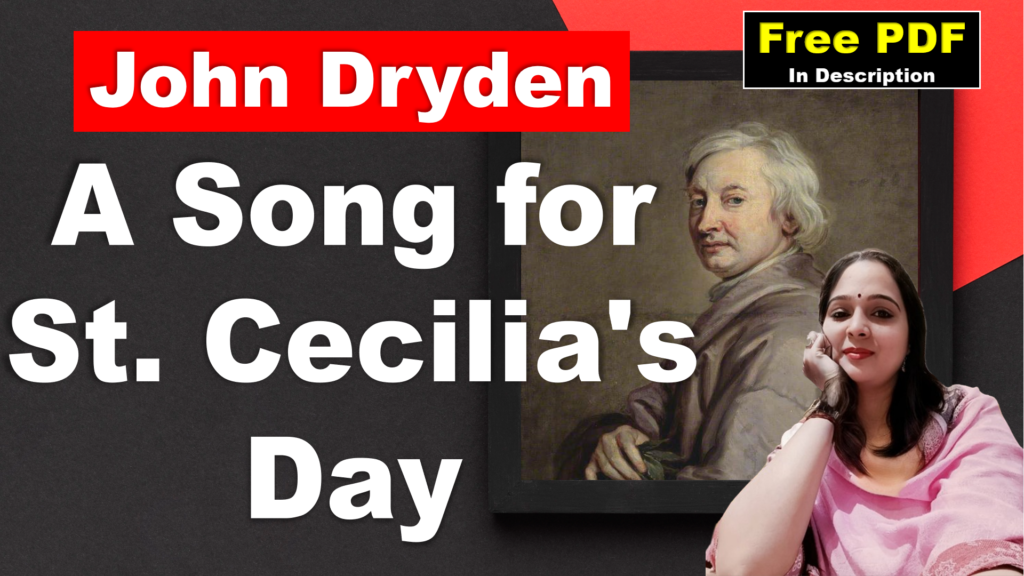
Essay Type Questions
Q. Write the critical appreciation of the poem?
Introduction
“A Song for St. Cecilia’s Day” by John Dryden is an ode written to celebrate Saint Cecilia, the patron saint of music. The poem is a rich and complex work that explores the power and influence of music on human emotions, the cosmos, and religious devotion. In this critical appreciation, we will analyze various aspects of the poem, including its structure, themes, poetic devices, and historical significance.
Structure and Form
The poem is written in a series of seven stanzas, each with a different focus and theme. This structured format allows Dryden to explore various aspects of music’s power systematically. The poem features a grand chorus at the end, creating a sense of culmination and celebration. The use of rhymed couplets adds a sense of musicality to the poem, reflecting its subject matter.
Themes and Motifs
The Power of Music:The primary theme of the poem is the extraordinary power of music to move, inspire, and transform. Dryden beautifully illustrates how music can evoke a wide range of emotions, from joy and celebration to sorrow and lamentation. This theme is explored through various musical instruments and their ability to convey human feelings.
Religious Devotion: As a hymn to Saint Cecilia, the poem also emphasizes the role of music in religious devotion. It portrays music as a means of praising and connecting with the divine. The angelic appearance in Cecilia’s story symbolizes the spiritual and transcendent quality of music.
The Cosmos and Harmony: Dryden links music to the order and harmony of the universe. He describes how music played a role in creating harmony out of chaos during the creation of the world. This theme highlights the idea that music is an essential part of the cosmic order.
Human Emotions: The poem delves into the emotional impact of music, from the passionate and intense to the soothing and consoling. It explores the capacity of music to elevate and express human feelings and experiences.
Poetic Devices
Imagery: Dryden uses vivid and sensory imagery to evoke the sounds and emotions associated with various musical instruments. This imagery helps readers feel the power of music.
Metaphor and Symbolism: The poem employs metaphors and symbols to convey abstract ideas, such as the idea of music “untuning the sky.” This metaphorical language adds depth and complexity to the poem.
Alliteration and Assonance: Dryden’s skillful use of alliteration and assonance enhances the musical quality of the poem, making it a sonic experience as well as a literary one.
Historical Significance
John Dryden, a prominent English poet of the 17th century, was an important figure in the literary and cultural landscape of his time. “A Song for St. Cecilia’s Day” reflects the broader cultural interest in music during the Baroque era. It showcases the fusion of poetry and music and the belief in the profound influence of music on human life. The poem’s themes and artistic qualities continue to resonate with readers and musicians, highlighting the enduring significance of the work.
Conclusion
“A Song for St. Cecilia’s Day” is a masterful ode that celebrates the transformative power of music and its ability to evoke deep emotions, connect with the divine, and shape the universe. Dryden’s use of structure, themes, and poetic devices creates a rich and immersive experience for readers, making the poem a timeless and compelling work in the world of English literature.
Q. Name the musical instruments mentioned in this poem. How does Dryden distinguish them from one another? Why does he regard the Organ as superior to all the other musical instruments?
The musical instruments mentioned in Dryden’s poem “A Song for St. Cecilia’s Day, 1687” are:
- Trumpet
- Drum
- Flute
- Violin
- Organ
Dryden distinguishes between these instruments based on their different sounds and the different emotions that they evoke. For example, he describes the trumpet as having a “loud clangor” that can “excite us to arms” (lines 2-3). He describes the drum as having a “thund’ring” sound that “cries, hark the foes come” (lines 6-7). He describes the flute as having a “soft complaining” sound that can “discover the woes of hopeless lovers” (lines 9-10). And he describes the violin as having a “sharp” sound that can “proclaim their jealous pangs and desperation” (lines 11-12).
Dryden regards the organ as superior to all the other musical instruments because of its power to evoke religious awe and to inspire holy love. He describes the organ as having “sacred notes” that can “wing their Heav’nly ways” and “mend the choirs above” (lines 17-18). He also describes the organ as having the power to “raise and quell” people’s passions and to “inspired holy love” (lines 16 and 19).
In addition to its religious significance, Dryden also praises the organ for its technical capabilities. He describes the organ as being able to produce a wide range of sounds, from the “soft complaining” of the flute to the “thund’ring” of the drum. He also praises the organ for its ability to sustain notes for long periods of time.
Overall, Dryden sees the organ as the most powerful and versatile musical instrument. He believes that the organ has the power to move and inspire people on both a physical and a spiritual level.
Here is a quote from the poem that illustrates Dryden’s high regard for the organ:
The organ loudly plays the notes divine,
And wings its Heav’nly ways:
Through all the compass of the notes it strays,
And mends the choirs above.
In this passage, Dryden describes the organ as playing “notes divine” and “wing[ing] its Heav’nly ways.” This suggests that he sees the organ as a sacred instrument that can connect us to the divine. He also praises the organ’s wide range and its ability to produce sustained notes.
Dryden’s poem is a celebration of the power of music, and the organ plays a central role in this celebration. Dryden sees the organ as the most powerful and versatile musical instrument, and he believes that it has the power to move and inspire people on both a physical and a spiritual level.





